As we reported last month, Star Trek: The Fall – a new five-book miniseries bridging the novelized adventures of Star Trek: The Next Generation and Star Trek: Deep Space Nine – is launching from Simon & Schuster, beginning with David R. George III’s newest release Revelation and Dust which was released on August 27.
TrekCore’s literature editor Dan Gunther caught up with the author earlier this month.
![]()
TrekCore: Your earliest Trek writing credit is as a co-writer on the first-season Voyager episode “Prime Factors.” Tell us a little bit about that experience.
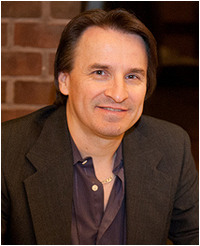 David R. George III: I had a friend who worked on Voyager and who was, like me, interested in writing for Star Trek. Because head writer Michael Piller maintained an open-submission policy for the various Trek series—not only an unusual policy, but one virtually unheard of in modern Hollywood—we were able to pitch a number of stories to writer-producers Mr. Piller, Jeri Taylor, and Brannon Braga.
David R. George III: I had a friend who worked on Voyager and who was, like me, interested in writing for Star Trek. Because head writer Michael Piller maintained an open-submission policy for the various Trek series—not only an unusual policy, but one virtually unheard of in modern Hollywood—we were able to pitch a number of stories to writer-producers Mr. Piller, Jeri Taylor, and Brannon Braga.
This happened during the filming of the pilot episode, meaning that we had to develop tales based solely on the series bible, a guide created by the show’s creators that spelled out the premise and characters of the series.
One of our ideas intrigued the producers enough to give us notes on it and ask us to come back with some minor changes. Our basic conceit was that the Voyager crew encountered a hedonistic species capable of sending them all the way (or at least most of the way) back to the Federation via an advanced transporter-like device, but that the aliens refused to do so because they possessed their own version of the Prime Directive, forestalling the sharing of their technology with others. Using the notes given to us, we wrote a modified version of the story, which we ended up selling to the show and which ultimately became “Prime Factors.”
The experience was certainly a positive one, but it also demonstrated the pressure in television to produce a piece of writing under significant time pressures. Writing in that medium is fulfilling, to be sure, but it is also not for the faint of heart.
TrekCore: What led you to begin writing Trek fiction, and how does that experience differ from writing for Voyager?
David R. George III: Through my friend who worked on both Voyager and Deep Space Nine, I was introduced to actor Armin Shimerman, who portrayed Quark on the latter show. Armin had already co-written a novel, The Merchant Prince, and was interested in penning episodes of his own series. We sat down with Armin on several occasions and worked out a number of stories for the show, and we then pitched them to writer-producers Ira Steven Behr, Ronald D. Moore, and René Echavarria.
Unfortunately, we didn’t sell any of our stories to the show, but Armin then suggested that we turn one of them into a novel. Although I initially scoffed at the notion that we could do that, I actually contacted John Ordover, who at that time was an editor on the Star Trek book line at Simon & Schuster. I asked Mr. Ordover if he would be interested in a Deep Space Nine novel with the name of one of the series’ regulars on the cover, and he indicated that he would, but that Armin and I would have to go through the same process of pitching as everybody else (our other collaborator bowed out, having no interest in that kind of writing).
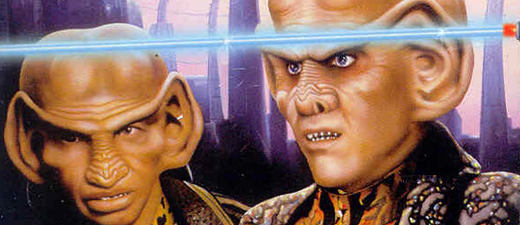 David co-wrote “The 34th Rule” with actor Armin Shimerman – a harrowing tale in which
David co-wrote “The 34th Rule” with actor Armin Shimerman – a harrowing tale in which
Rom and Quark are imprisoned in the Gallitep labor camp on Bajor.
That entailed a substantial amount of work. First, we would need to produce a detailed narrative outline, describing the beginning, middle, and end of our story, its major plot points, and the character arcs. Second, if we could get our outline approved, we would then have to submit the first three chapters of the tale—approximately fifty or so pages—in order to demonstrate that Armin and I actually possessed the ability to pen a novel.
Over the course of about three weeks, Armin and I met enough times to expand our story and map it out from beginning to end. Writing a novel with a contractual minimum of 70,000 words—which equates to approximately 280 manuscript pages—requires the creation of a considerably more involved tale than does crafting a 60-page teleplay. To that end, Armin and I added a great deal of complexity to our story, which we originally called War Is Good for Business, but which we ultimately titled The 34th Rule. And as it turned out, The 34th Rule would clock in at 135,000 words.
Once Armin and I had completed the outline, we submitted it to Simon & Schuster. Fifteen minutes later, I received word from John Ordover that he would buy it from us. I asked about the first fifty pages of the novel that he said he would want to see, but he told me that the strength of the writing in the outline demonstrated to him Armin’s and my abilities.
TrekCore: Your newest novel, Revelation and Dust, is the first book in a new miniseries entitled The Fall. What can you tell us about that particular story, and how have you found the experience of working with your fellow authors to craft the overall tale?
David R. George III: The story I developed for Revelation and Dust essentially had to serve three different masters. On the one hand, my tale needed to launch the five-book arc that would continue with Una McCormack’s The Crimson Shadow, David Mack’s A Ceremony of Losses, James Swallow’s The Poisoned Chalice, and conclude with Dayton Ward’s Peaceable Kingdoms.
On the second hand, it would have to renew the ongoing Deep Space Nine saga, which in the Star Trek literary world has continued forward from the end of the television series. And on the third hand (this is science fiction, so I’m sure none of us will have any trouble positing a third hand), my novel would have to introduce the brand-new Deep Space 9 space station.
Although I already had in mind some DS9 elements that I wanted to write, I first met with editor Margaret Clark and the other writers of The Fall to determine the overall tale we wanted to tell. Our idea was that we would each produce a novel that would satisfy in and of itself, but that when read with the other entries in the series would tell a larger tale as well. Ms. Clark and all of the writers are consummate, creative professionals.
I found it not only easy to work with all of them, but also very rewarding. We very quickly settled on the direction in which we wanted to head, and then worked out our individual pieces of the puzzle. Throughout that process, and then through the writing of the books, we consulted with our editor and with each other to ensure that we maintained both continuity and pacing. I think we’ve come up with a series of novels that Trek readers will enjoy.
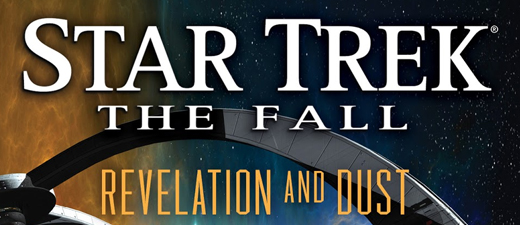 Revelation and Dust kicks off a new five-part miniseries entitled The Fall.
Revelation and Dust kicks off a new five-part miniseries entitled The Fall.
As for the overall story, I’ll simply say that in Revelation and Dust, a major event takes places in the Star Trek universe that will have significant repercussions throughout the Federation and well beyond its borders.
TrekCore: The character of Kira Nerys has had an interesting journey in recent years. She went from commanding DS9 to living as a Vedek, and her final fate in your last Typhon Pact novel remains somewhat of a mystery. Will we learn more about Kira’s recent past, as well as her current whereabouts and situation in Revelation and Dust?
David R. George III: I love the character of Kira Nerys. Throughout the series and then into the novels, she has been a complex, engaging character who is incredibly fun to watch, to read, and to write. Her journey in the television series—which took her from a life spent rebelling against alien occupiers, into the Bajoran Militia, and from there to working with Starfleet aboard Deep Space 9—felt like a natural progression.
Since the end of the show, which concluded with her taking command of the station, Kira has participated in the process of seeing her people join the Federation, been attainted from her religion, been readmitted, resigned her commission, and become an established member of her religion. It has been a fascinating journey, although readers have yet to witness all the steps she’s taken, since a period of time—roughly 2377 through 2380—has thus far gone undocumented in the DS9 novels. If the books continue to sell well, though, there is every chance that at least some of those developments will be explored in more detail somewhere down the road.
As for Kira’s most recent past, readers last saw her in Raise the Dawn, in 2383, when she was apparently lost in the collapse of the Bajoran wormhole. Events in that novel, though, made it pretty clear—or at least hinted very strongly—that Kira did not perish. Just before the wormhole collapsed, she received an unexpected visit aboard her runabout, from a character whose presence suggests that he was there to help her, perhaps even at the behest of the Prophets. The very beginning of Revelation and Dust picks up precisely where Kira’s story left off, so yes, readers will definitely learn about her current whereabouts and situation.
TrekCore: You excel in particular at finding the voice of the characters you write. For example, Sisko’s story arc in Rough Beasts of Empire through Raise the Dawn put him in a difficult place, but the story stayed very true to his character. Do you find speaking in the characters’ voices an easy process, or is it challenging to create meaningful dialogue and experiences for them?
David R. George III: I appreciate the kind words about finding the voices of the characters. When I’m writing, I visualize scenes and hear the words the characters are speaking, almost as though I’m watching it unfold on television or in a film. In penning works for a media–tie-in entity, I think it is particularly important to get the voices right.
The challenge for me doesn’t come in crafting dialogue, but in deciding on the character arcs. In my case, writing the narrative outline for a Trek novel—or any novel—is the most difficult writing I do. Although it takes much more time to write an entire novel because it so much longer than the corresponding outline, it is the outline that is excruciating to produce. This is because it is at that initial stage that I must essentially decide upon all of the major ingredients of the book: its themes, its plot, its character arcs. I have to know precisely where I’m going in order to get there. That doesn’t mean that there isn’t room to deviate from the outline, but it does mean I have to make a lot of major decisions in a relatively short amount of time.
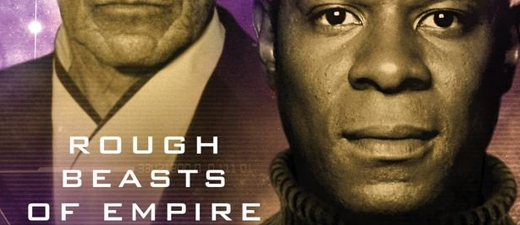 Sisko’s big decision in “Rough Beasts of Empire” cause a major impact to his family life.
Sisko’s big decision in “Rough Beasts of Empire” cause a major impact to his family life.
On top of that, I have discovered that I like to challenge myself. From one novel to the next, I often attempt to increase the degree of difficulty. I want to succeed in writing a good novel, and in writing good Star Trek, but I also want to raise the bar for myself.
In attempting to do that, I sometimes also end up challenging my readers. You mentioned that I put Ben Sisko in a difficult place in Rough Beasts of Empire, but that the story still stayed true to his character. I believe that is the case, but I know that not all readers would agree—and I knew that even before I wrote the first sentence of the novel. That’s because I ended up having Sisko take actions that I knew some readers would regard as cowardly or undesirable, and therefore as out of character. I decided on that course, though, for a couple reasons.
First, I really wanted to pay off something that had originated in the television show—a declaration made to Sisko by the Prophets—but that never paid off in the series; it also hadn’t yet paid off in the literary Trek world either, so I wanted to get that done. Second, I sought to challenge not only myself and my readers, but also the character of Ben Sisko. Heroes are not heroes because they always do the right thing in the easiest of circumstances; they are heroic because they face adversity, and I think they are often far more interesting when they sometimes make mistakes.
That said, I don’t necessarily think that Sisko made the mistakes some readers might have thought he did. He faced an impossible dilemma: either leave the people you love the most, or stay with them and put their lives at risk of almost certain death. I think, overall, he made the only decision he could—and it was a decision, in one form or another, that we had already seen him make in the actual television series.
TrekCore: In your recent Original Series novel, Allegiance in Exile, we caught a glimpse of the Ascendants and their relationship with the Bajorans. Many fans would love to see the resolution of their story arc between The Soul Key and your own Plagues of Night. Is there a chance that their story may one day be told in full?
David R. George III: There is certainly a chance that readers might one day see the resolution to the Ascendants story arc, but that will in large part depend on the readers themselves. If enough of them continue to show interest in Deep Space Nine by purchasing the novels, then the probability of that line of books continuing will increase. As a reader and fan myself of the ongoing DS9 literary saga, I am as hopeful as everybody else that we’ll one day get to read that tale. And of course, I’d also love to write it.
TrekCore: Although we still eagerly await the release of your newest novel, one aspect of Revelation and Dust that has been seen by everyone is the gorgeous cover, featuring the newly re-built Deep Space 9. What role did you play in helping realize the design of the new station? Was the design based solely off of your description in Raise the Dawn, or was there greater consultation along the way?
David R. George III: I provided readers with a rudimentary description of the new station at the very end of Raise the Dawn. I had a definite image in mind, and I asked my editor, Ed Schlesinger, if there was any chance that we could get a rendering of the new DS9 on the cover of Revelation and Dust. To my delight, he made that happen. Academy and Emmy Award winner Doug Drexler was hired to produce the cover art, and Doug in turn enlisted artists/designers Andrew J. Probert and Douglas Graves to build the digital model of the station.
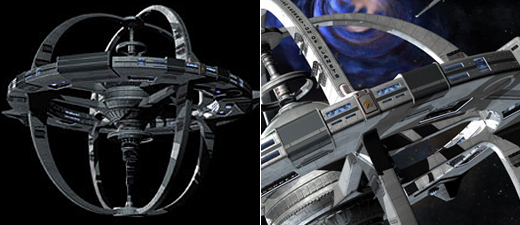 The images of the new DS9 were created by Doug Drexler, Andy Probert, and Douglas Graves.
The images of the new DS9 were created by Doug Drexler, Andy Probert, and Douglas Graves.
During that process, I consulted about the design, since I had initiated it and had a particular idea in my head. Recognizing that the three other individuals involved also needed to satisfy their own creativity, I did not object to several alterations, so long as they did not contradict the description of the station that had already seen print. In some cases, Doug or Andy or Douglas added or modified details that absolutely improved the design. I am very grateful for their talents and their professionalism.
TrekCore: According to your Facebook page, you’ve been working on a new Star Trek novel, but you’ve had to be coy about the details. Is there any chance that our readers could get some hints or sneak peeks?
David R. George III: Me? Coy? Whatever do you mean?
Oh. Yeah. I see your point. All right. I’ll give you this: my next Star Trek novel will take place during the so-called Lost Era, the large gap of time between Star Trek VI: The Undiscovered Country and the launch of the Enterprise-D in “Encounter at Farpoint.”
TrekCore: Your Star Trek novels have spanned many time periods, from the Original Series to The Lost Era and the post-Nemesis relaunch era. Which is your favorite series or time period to write about? Are there any periods of Trek history or series that you haven’t gotten a chance to contribute to that you would one day like to?
David R. George III: This is going to sound like a non-answer, but it’s the truth: my favorite series or time period to write happens to be whatever one I’m writing. I know that might sound ridiculous to some people, but if I’m involved in producing a novel, a process that takes a great deal of time, effort, and emotion, I have to be really invested in it. At the moment, I am very much into the time period 2303-2319.
As for series to which I’d like to contribute, my only Next Generation entry has been a short alternate-universe novel, The Embrace of Cold Architects, in the third Myriad Universes volume, Shattered Light. I think I might like a crack at telling a longer, main-universe TNG tale.
TrekCore: Outside of the world of Trek, what projects are you working on that our readers should know about?
David R. George III: I have had two novelettes published that are science fiction, but not Star Trek.
The first, “Moon Over Luna,” was originally published in the paperback anthology Thrilling Wonder Stories, Volume 2, but which I recently published as an e-book for $0.99. The second novelette was published in the third ReDeus anthology, Native Lands, and it’s called “The Instruments of Vice.” The anthology is available both as a paperback and as an e-book on Amazon.com.
At the moment, I am also working on several other projects, but I’m unfortunately not at a stage where I can say anything about any of them.
David R. George III can be found on Facebook and Twitter.
![]()
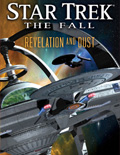 |
Order Star Trek The Fall: Revelations and Dust |
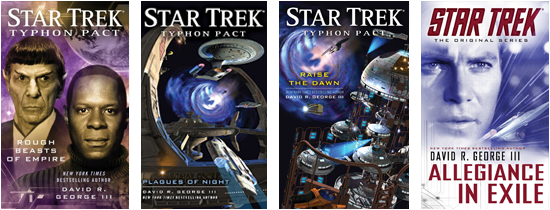 |
|||
| Amazon US Amazon UK Amazon DE |
Amazon US Amazon UK Amazon DE |
Amazon US Amazon UK Amazon DE |
Amazon US Amazon UK Amazon DE |
